1996 PONTIAC PONTIAC lights
[x] Cancel search: lightsPage 6 of 370
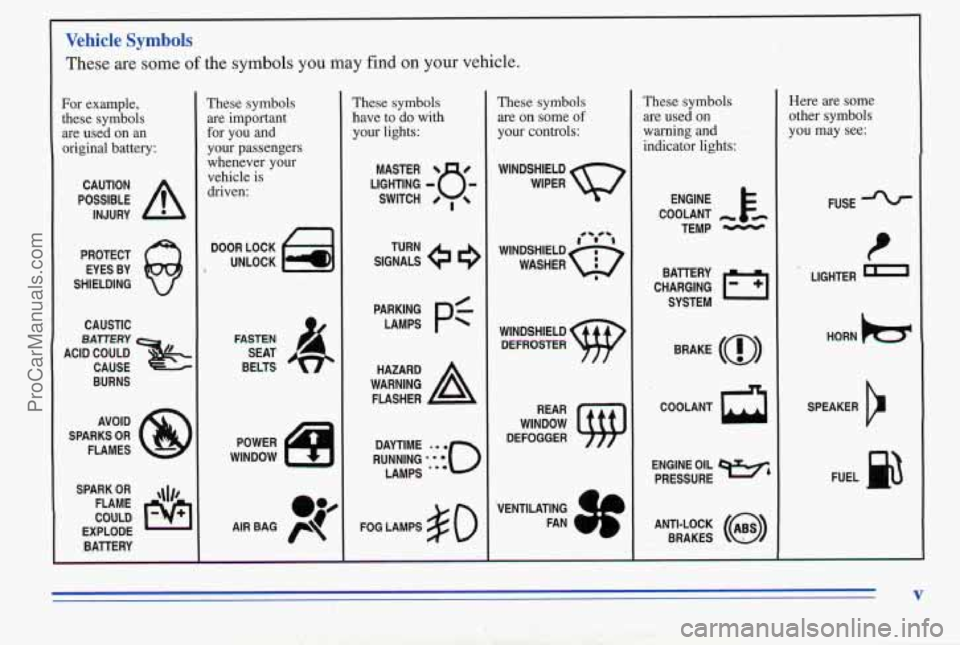
1
Vehicle Symbols
These are some of the symbols you may find on your vehicle.
For example,
these symbols are used on an
original battery:
POSSIBLE A
CAUTION
INJURY
PROTECT EYES BY
SHIELDING
CAUSTIC
ACIEEZ CAUSE
BURNS
AVOID
SPARKS
OR
FLAMES
SPARK
OR ,\I/,
COULD FLAME
EXPLODE BATTERY
These symbols
are important
for you and
your passengers
whenever your
vehicle is driven:
DOOR LOCK
UNLOCK
FASTEN SEAT
BELTS
POWER
WINDOW
c
These symbols
have to do with
your lights:
SIGNALS e 9
TURN
PARKING
PC
LAMPS
FOG LAMPS $0
These symbols
are
on some of
your controls:
WINDSHIELD
WIPER
'VENTILATING
FAN
These symbols
are used on
warning and
indicator lights:
COOLANT -
TEMP -
CHARGING 1-1
BATTERY
SYSTEM
BRAKE
(0)
COOLANT a
ENGINE OIL w,
PRESSURE
ANTI-LOCK
(@)
BRAKES
Here are some
other symbols
you may see:
FUSE
P
LIGHTER m
HORN )cr
SPEAKER
b
FUEL e3
V
ProCarManuals.com
Page 80 of 370

OFF (C): This position lets you turn off the engine but
still tuin the steering wheel. It doesn’t lock the steering
wheel like
LOCK. Use OFF if you must have your
vehcle pushed
or towed.
RUN (D): This position is where the key returns
after you start your vehicle. With the engine
off, you
can use
RUN to display some of your warning and
indicator lights.
: START (E): This position starts your engine.
A warning chime will sound
if you open the driver’s
door when the ignition is in the
OFF, LOCK or ACC
position and the key
is in the ignition.
NOTICE:
If your key seems stuck in LOCK and you can’t
turn it, be sure it
is all the way in. If it is, then
turn the steering wheel left and right while you
turn the key hard. But turn the key only with
your hand. Using
a tool to force it could break
the key or the ignition switch.
If none of this
works, then your vehicle needs service.
Starting Your Engine
Move your shift lever to PARK (P) or NEUTRAL (N).
Your engine won’t start in any other position -- that’s a
safety feature.
To restart when you’re already moving,
use
NEUTRAL (N) only.
NOTICE:
Don’t try to shift to PARK (P) if‘ your Pontiac
is moving.
If you do, you could damage the
transaxle. Shift to PARK
(P) only when your
vehicle is stopped.
1. Without pushing the accelerator pedal, turn your
ignition key
to START. When the engine starts, let
go of the key. The idle speed will go down as your
engine gets warm.
2-11
ProCarManuals.com
Page 101 of 370
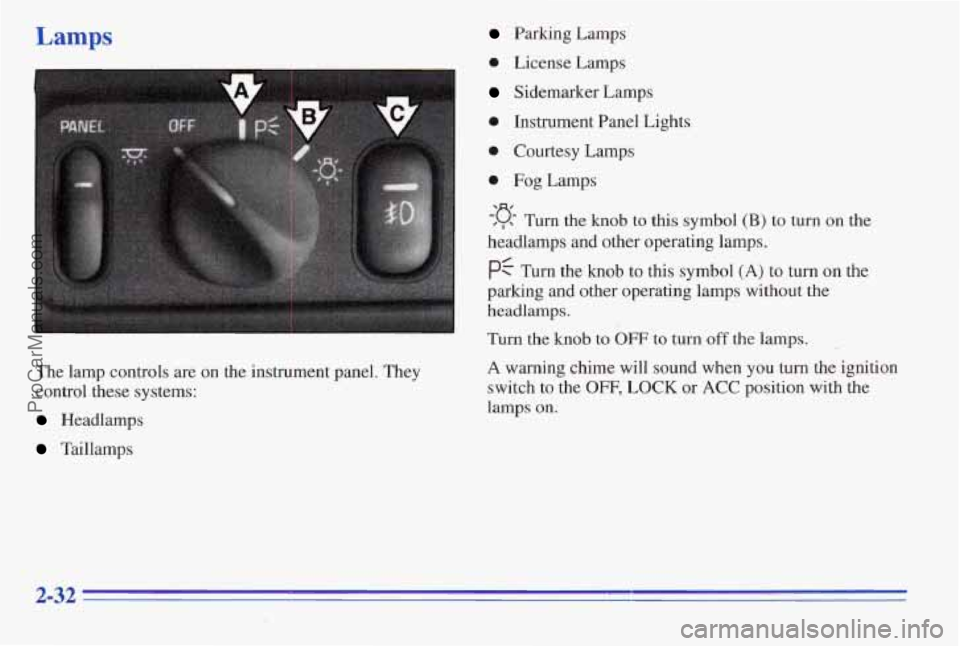
Lamps
The lamp controls are on the instrument panel.Vhey
control these systems:
Headlamps
Taillamps
Parking Lamps
0 License Lamps
Sidemarker Lamps
0 Instrument Panel Lights
0 Courtesy Lamps
0 Fog Lamps
-:q- Turn the knob to this symbol (B) to turn on the
headlamps and other operating lamps.
pf Turn the knob to this symbol (A) to turn on the
parking
and other operating lamps without the
headlamps.
Turn the knob to OFF to turn off the lamps.
A warning chime will sound when you turn the ignition
switch to the
OFF, LOCK or ACC position with the
lamps on.
2-32 --
ProCarManuals.com
Page 103 of 370
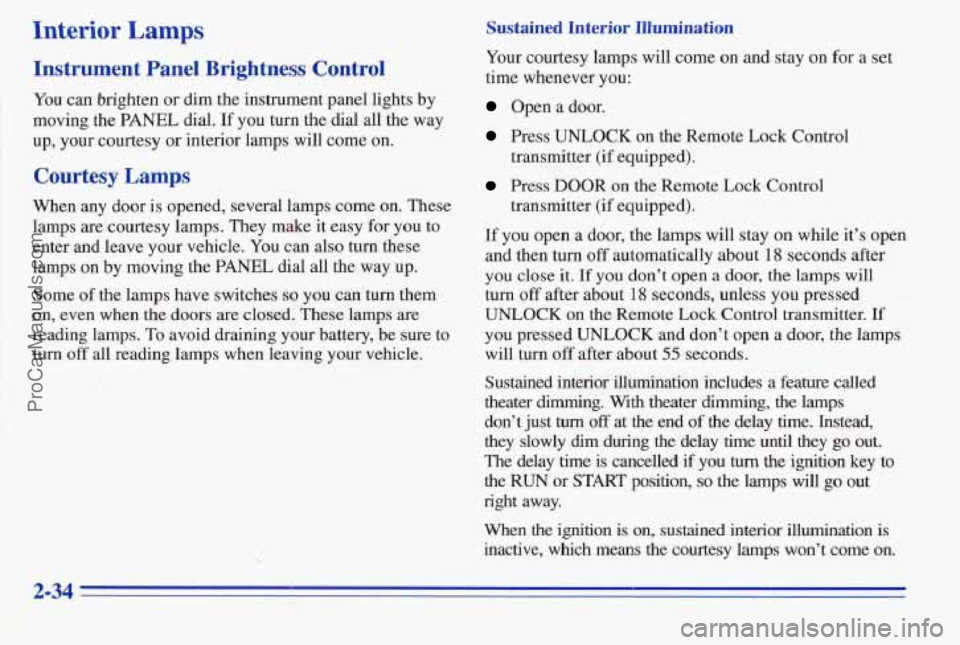
Interior Lamps
Instrument Panel Brightness Control
You cm brighten or dim the instrument panel lights by
moving the
PANEL dial. If you turn the dial all the way
up, your courtesy or interior lamps will come on.
Courtesy Lamps
When any door is opened, several lamps come on. lltllese
lamps are courtesy lamps. They make it easy for you
to
enter and leave your vehicle. You can also tun these
lamps on by moving the
PANEL dial all the way up.
Some of the lamps have switches
so you can turn them
on, even when the doors are closed. These lamps are
reading lamps. To avoid dtaining your battery, be sure to
turn
off all reading lamps when leaving your vehicle.
Sustained Interior Illumination
Your courtesy lamps will come on and stay on for a set
time whenever
you:
Open a door.
Press UNLOCK on the Remote Lock Control
transmitter (if equipped).
transmitter (if equipped).
Press DOOR on the Remote Lock, Control
If you open a door, the lamps will stay on while it’s open
and then turn off automatically about 18 seconds after
you close
it. If you don”t open a door, the lamps will
turn
off after about 18 seconds, unless you pressed
UNLOCK on the Remote Lock Control transmitter.
If
you pressed UNLOCK and don’t open a door, the lamps
will turn
off after about 55 seconds.
Sustained interior illumination includes a feature called
theater
dimming. With theater dimming, the lamps
don’t just
turn off at the end of the delay time. Instead,
they slowly
dim during the delay time until they go out.
The delay tirne is cancelled if you turn the ignition key to
the
RUN or START position, so the lamps will go out
right away.
When the ignition is
on, sustained interior illumination is
inactive, which means the courtesy lamps won’t come on.
2-34
ProCarManuals.com
Page 115 of 370

Wslrr!ing Lights, Gages and Indicators
This part des’cribes the warning lights and gages that may
be on your vehicle. The pictures will help you locate them.
Warning lights and gages can signal that something
is
wrong before it becomes serious enough to cause an
expensive repair or replacement. Paying attention to
your warning lights and gages could also save you or
others from injury.
Warning lights come on when there
may be QT is a
problem with one
of your vehicle’s functions. As you will
see in the details on the next few pages, some warning
lights come on briefly when you start the engine just to let
you know they’re working. If you are familiar with this
section, you should not be alarmed when this happens.
Gages can indicate when there
may be or is a problem
with one of your vehicle’s functions. Often gages
and
warning lights work together to let you know when
.-:.‘:?there’s
. .. a problem with your vehicle.
I!;.. ’ ’
I.
When one of the warning lights comes on and stays on
when you are driving,.or when one of the gages shows
there may be a problem, check the section that tells you
what to
do about it. Please follow this manual’s advice.
Waiting to
do repairs can be costly -- and even
dangerous.
So please get to know your warning lights
and gages.
They’re a big help.
Safety Belt Reminder Light
When the key is turned to RUN or START, a chime will
come on for about eight seconds to remind people to
fasten their safety belts, unless
the driver’s safety belt is
already buckled.
The safety belt light
will also come on and
, .!
stay on until the driver3
belt
is buckled.
,.
2-46
ProCarManuals.com
Page 127 of 370
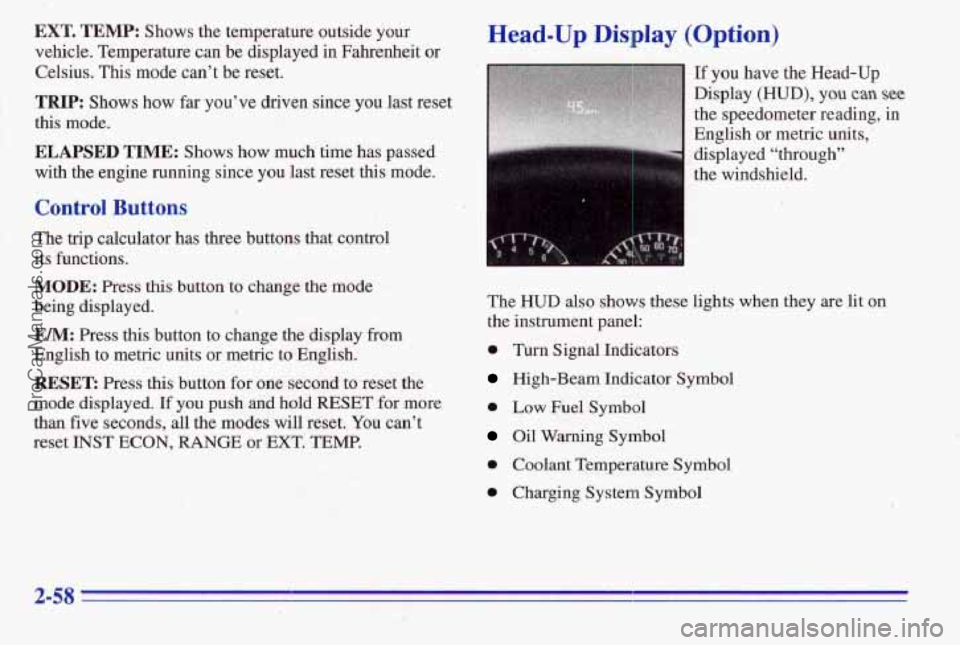
EXT. TEMP: Shows the temperature outside your
vehicle. Temperature can be displayed in Fahrenheit or
Celsius. This mode can’t be reset.
TRIP: Shows how far you’ve driv’en since you last reset
this mode.
ELAPSED TIME: Shows how much time has passed
with the engine running since you last reset this mode.
Control Buttons
The trip calculator has three buttons that control
its functions.
MODE: Press this button to change the mode
being displayed.
EM: Press this button to change the display from
English to metric units or metric to English.
RESET: Press this button for one second to reset the
mode displayed.
If you push and hold RESET for more
than five seconds, all the modes will reset. You can’t
reset
INST ECON, RANGE or EXT. TEMP.
Head-Up Display (Option)
If you have the Head-Up
Display
(HUD), you can see
the speedometer reading, in
English or metric units,
’
displayed “through”
the windshield.
The
HUD also shows these lights when they are lit on
the instrument panel:
0 Turn Signal Indicators
High-Beam Indicator Symbol
0 Low Fuel Symbol
Oil Warning Symbol
0 Coolant Temperature Symbol
0 Charging System Symbol
ProCarManuals.com
Page 170 of 370
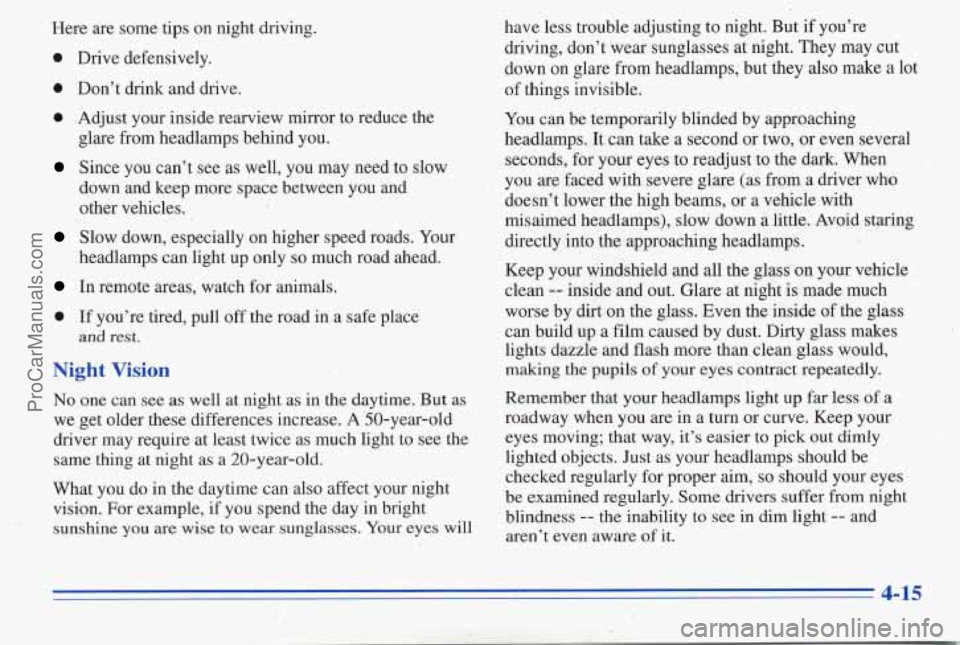
Here are some tips on night driving.
0 Drive defensively.
0 Don’t drink and dnve.
0 ,Adjust your inside rearview mirror to reduce the
Since you can’t see as well, you may need to slow
glare from headlamps behind you.
down and ke,ep more space between you and
other vehicles.
Slow down, especially on higher speed roads. Your
headlamps can light up only
so much road ahead.
In remote areas, watch for animals.
0 If you’re tired, pull off the road in a safe place
and rest.
Night Vision
No one can see as well at night as in the daytime. But as
we get older these differences increase.
A 50-year-old
driver may require at least twice as much light to see the
same thing at night as a 20-year-old.
What you do in the daytime can also affect your night
vision. For example, if you spend the day in bright
sunshine you are wise to wear sunglasses. Your eyes will
have less trouble adjusting to night. But if you’re
driving, don’t wear sunglasses at night. They may cut
down on glare from headlamps, but they
also make a lot
of things invisible.
You can be temporarily blinded by approaching
headlamps. It can take a second or two,
or even several
seconds, for your eyes to readjust to the dark. When
you
are faced with severe glare (as from a driver who
doesn’t lower the high beams, or a vehicle with
misaimed headlamps), slow down a little. Avoid staring
directly into the approaching headlamps.
Keep your windshield and
all the glass on your vehicle
clean
-- inside and out. Glare at night is made much
worse by dirt
on the glass. Even the inside of the glass
can build
up a film caused by dust. Dirty glass makes
lights dazzle and flash more than clean glass would,
making the pupils of your eyes contract repeatedly.
Remember that your headlamps light
up far less of a
roadway when you are in a turn or curve. Keep your
eyes moving; that way, it’s easier to pick out dimly
lighted objects. Just as your headlamps should be
checked regularly for proper aim,
so should your eyes
be examined regularly. Some drivers suffer from night
blindness
-- the inability to see in dim light -- and
aren’t even aware
of it.
4-15
ProCarManuals.com
Page 191 of 370
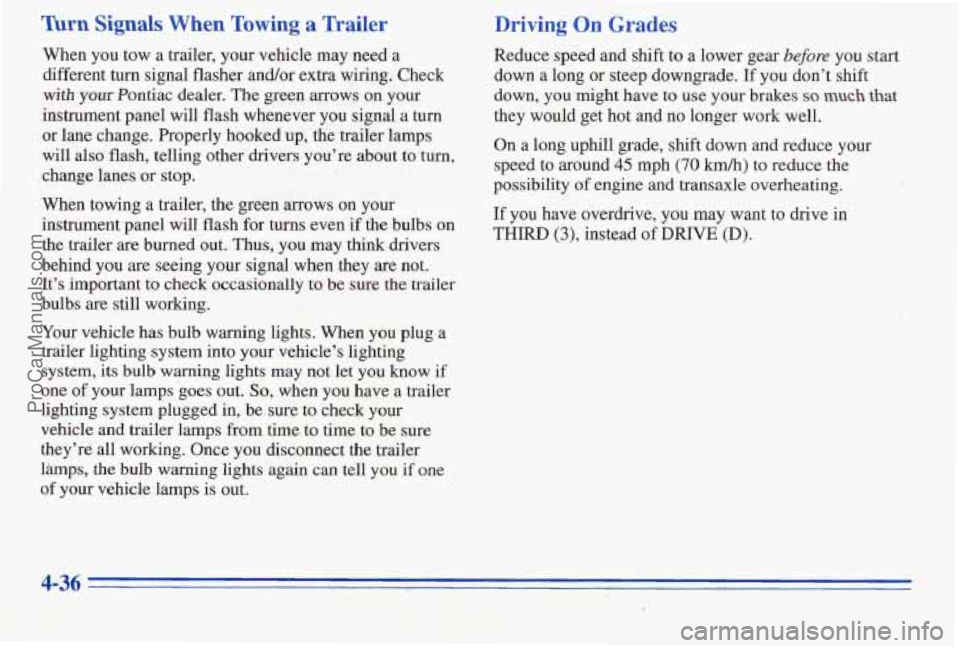
Turn Signals When Towing a Wailer
When you tow a trailer, your vehicle may need a
different turn signal flasher and/or extra wiring. Check
with your Pontiac dealer. The green arrows on your
instrument panel will
flash whenever you signal a turn
or lane change. Properly hooked up, the trailer lamps
will also flash, telling other drivers you’re about to
turn,
change lanes or stop.
When towing a trailer, the green arrows on your
instrument panel will, flash for turns even if the bulbs
on
the trailer are burned out. Thus, you may think drivers
behind you are seeing your signal when they are not.
It’s important to check occasionally
to be sure the trailer
bulbs are still working.
Your vehicle has bulb warning lights. When you plug a
trailer lighting system into your vehicle’s lighting
system, its bulb warning lights may not let you
know if
one
of your lamps goes out. So, when you have a trailer
lighting system plugged
in, be sure to check your
vehicle and trailer lamps from time to time to be
sure
they’re all working. Once you disconnect the trailer
lhmps,
the bulb warning lights again can tell you if one
of your vehicle lamps is out.
Driving On Grades
Reduce speed and shift to a lower gear before you start
down a long or steep downgrade. If you don’t shift
down, you might have to use your
brakes so much that
they wouJd get hot and no longer work well.
On a long uphill grade, shift down and reduce your
speed to around
45 mph (70 km/h) to reduce the
possibility
of engine and transaxle overheating.
If you have overdrive, you may want to drive in
THIRD (3), instead of DRIVE (D).
4-36
ProCarManuals.com